With 4.48 billion global email users in 2024 and an expected growth to 4.89 billion by 2027, email remains one of the most effective marketing channels.
This guide looks at the best email marketing tools in 2025, comparing their key features, pricing, and real benefits. We focus on tools that actually help you send campaigns, track results, and grow your business - without requiring a degree in marketing.
For each tool, we break down what it’s really good at, who it works best for, and what limitations you should know about before signing up.
Let’s explore the top email marketing platforms to help you find the right fit for your needs.
Quick Tip: Want better email open rates? Check our “Guide To Best Times To Send Emails in 2024” before starting your campaigns.
5 Best Email Marketing Tools for Small Businesses in 2025
Small businesses need reliable email marketing tools to run campaigns, send automated messages, and track results without spending too much time or money.
We compared leading email marketing platforms offering different features and pricing options to match various business needs.
Omnisend
Omnisend helps online stores run their email, SMS, and push notification campaigns from a single dashboard.
It automates marketing tasks like abandoned cart recovery and welcome messages, while letting store owners create professional-looking emails using drag-and-drop tools.
The platform connects directly to your online store to keep product information current and helps track how customers interact with your messages.
Key Features
Omnisend includes essential tools that make email marketing easier for online stores:
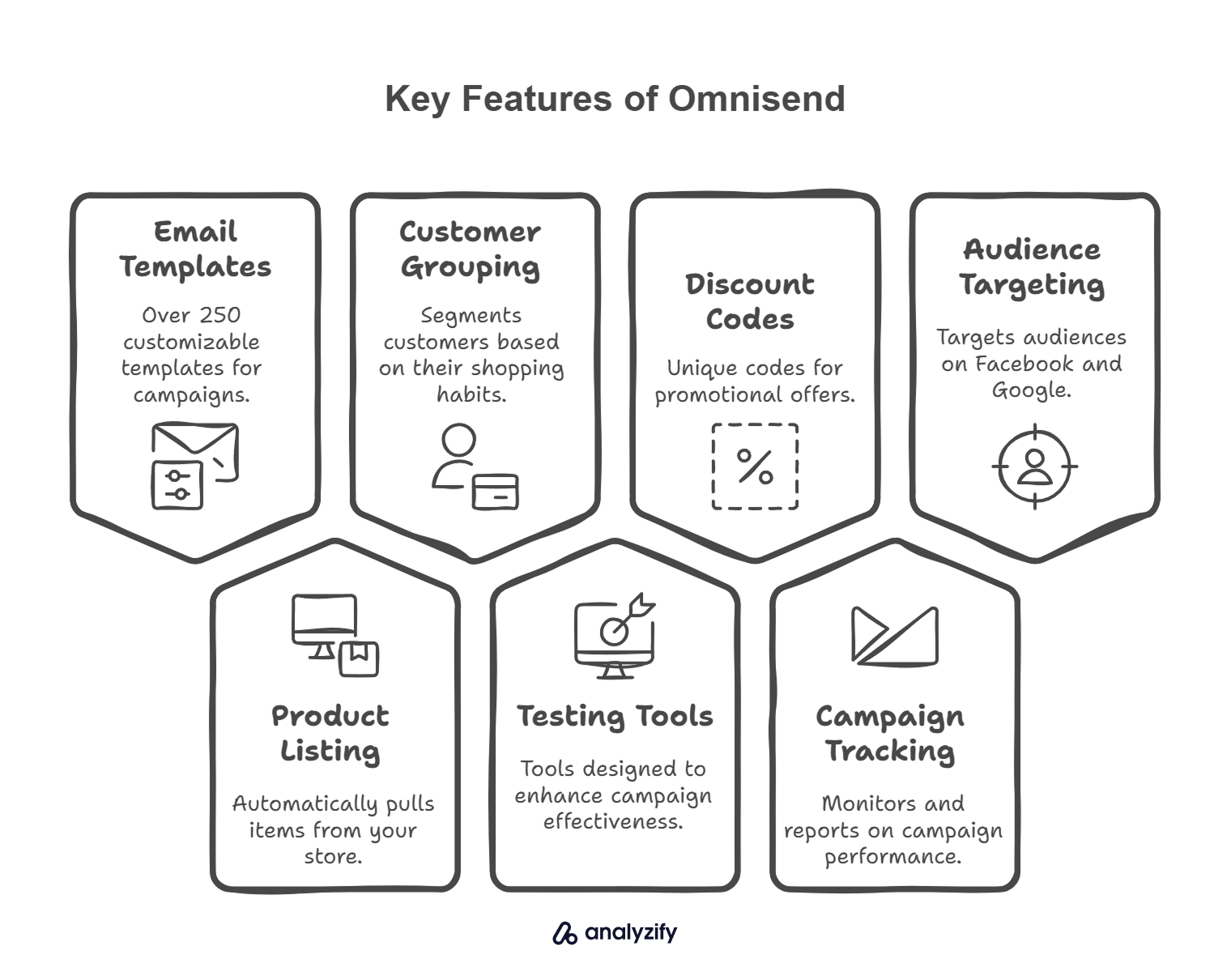
- Over 250 ready-to-use email templates with drag-and-drop editing
- Product listing that pulls items directly from your store
- Customer grouping based on shopping behavior
- Testing tools to improve campaign performance
- Unique discount codes for special offers
- Campaign tracking and reports
- Facebook and Google audience targeting
Best Suited For
Omnisend works best for small to medium-sized online stores looking for a complete marketing tool. It’s particularly helpful for businesses that want to create professional marketing campaigns without hiring a designer.
The platform suits store owners who need to send both email and text messages to their customers, and who want their marketing to respond automatically to customer actions like abandoned carts or recent purchases.
Advantages and Disadvantages
Omnisend excels at helping businesses run marketing campaigns across email, SMS, and web notifications from one place.
Its direct connection to online stores means product information stays up-to-date automatically, saving time on campaign creation and reducing errors.

Key advantages:
- Easy-to-use email builder with drag-and-drop features
- Built-in SMS and push notification tools
- Customer grouping based on shopping behavior
- Ready-to-use workflows for abandoned cart recovery
When it comes to limitations, Omnisend’s pricing may be too high for very small businesses just getting started.
The platform also requires time to learn, especially when setting up automated campaigns or using advanced features like custom code editing.
Key disadvantages:
- More expensive than basic email tools
- Limited design options for custom coding
- Fewer integration options outside online stores
- Takes time to set up and learn all features
Pricing
Omnisend offers different plans to match various business needs and sizes:
| Plan | Price | Features |
| Free Plan | $0 | Up to 250 contacts, 500 emails per month, basic email templates |
| Standard Plan | $11.20 per month (paid annually) | Up to 500 contacts, 6,000 emails per month, all email templates, SMS marketing features |
| Pro Plan | $41.30 per month | Up to 2,500 contacts, unlimited emails, advanced reporting, priority support |
Constant Contact
Constant Contact combines email, event management, and social media marketing tools in one platform.
The service targets small businesses with basic marketing needs, offering features like email automation, event registration, and social media integration.
Key Features
Constant Contact works best for small businesses that want simple marketing tools and need event management features.

- Drag-and-drop email editor with over 200 templates
- Event management tools for registration and ticket sales
- Email automation for basic workflows
- Social media marketing tools and ad creation
- A/B testing capabilities for email campaigns
- Built-in survey and polling tools
- AI-powered content generation for emails and social posts
Best Suited For
It’s particularly useful for organizations that host regular events, workshops, or classes, as it includes built-in event registration and ticketing features.
Advantages and Disadvantages
Constant Contact excels at providing straightforward email marketing tools with good deliverability rates. Its direct connection with social media platforms helps businesses manage their online presence from one place.
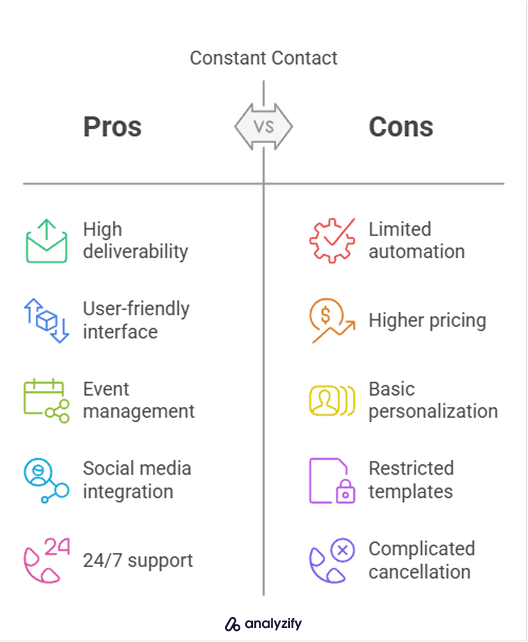
Key advantages:
- High email deliverability rates (consistently above 88%)
- Easy-to-use interface with drag-and-drop editing
- Integrated event management and ticketing system
- Strong integration with social media platforms
- 24/7 customer support through phone and chat
However, there are notable limitations that might affect some users. The platform’s focus on simplicity means it lacks some advanced features found in competing tools.
Key disadvantages:
- Limited automation capabilities compared to competitors
- Higher pricing than similar tools in the market
- Basic personalization options
- Restricted template customization options
- Must call to cancel subscription
Pricing
Constant Contact offers three main pricing tiers:
| Plan | Price | Features |
| Lite Plan | Starts at $12/month for up to 500 contacts | Basic email marketing features, limited to single user |
| Standard Plan | Starts at $35/month for up to 500 contacts | Includes automation features, supports up to three users, access to all email templates, additional marketing features |
| Premium Plan | Starts at $80/month for up to 500 contacts | Unlimited users, advanced automation, custom integrations, priority support |
All plans increase in price based on the number of contacts. For event features, there’s an additional fee of 5.4% + $0.80 per ticket sold.
Campaigner
Campaigner specializes in behavior-based email automation and multi-channel marketing campaigns.
Originally launched in 1999, it gives businesses tools for creating targeted campaigns based on user behavior and purchase history, with support for multiple languages and advanced segmentation features.
Key Features
Campaigner excels at providing detailed audience segmentation and ecommerce integration capabilities.
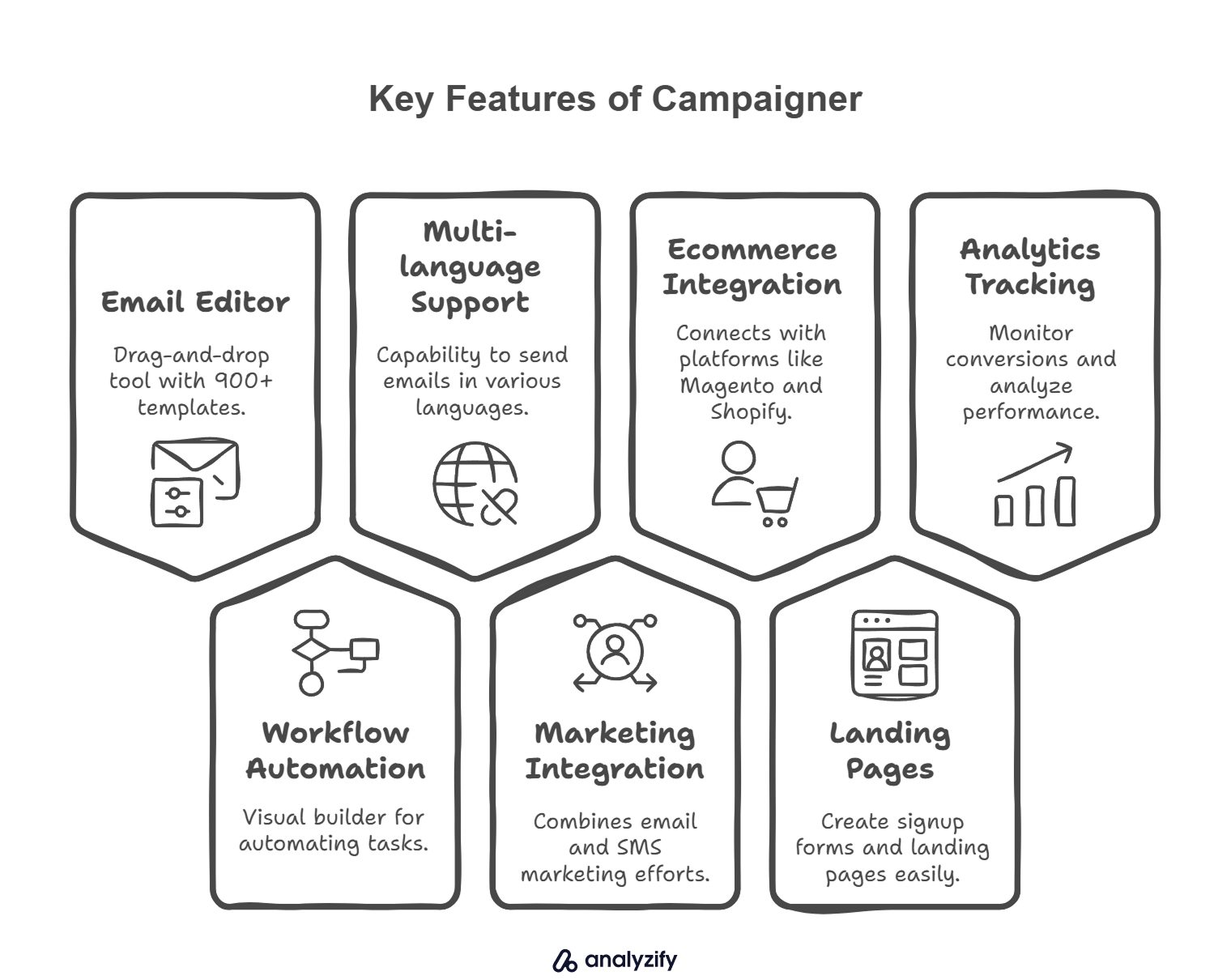
- Drag-and-drop email editor with over 900 templates
- Visual workflow automation builder
- Segmentation and A/B testing tools
- Multi-language email support
- Email and SMS marketing integration
- Ecommerce platform integration (Magento and Shopify)
- Landing page and signup form creation
- Conversion tracking and analytics
Best Suited For
Campaigner works best for mid-sized businesses that need detailed audience segmentation and ecommerce integration.
It’s particularly valuable for companies managing multiple brands or requiring multi-language support for international audiences.
Advantages and Disadvantages
Its direct connection with major ecommerce platforms and multi-language support helps businesses manage complex marketing operations from one place.
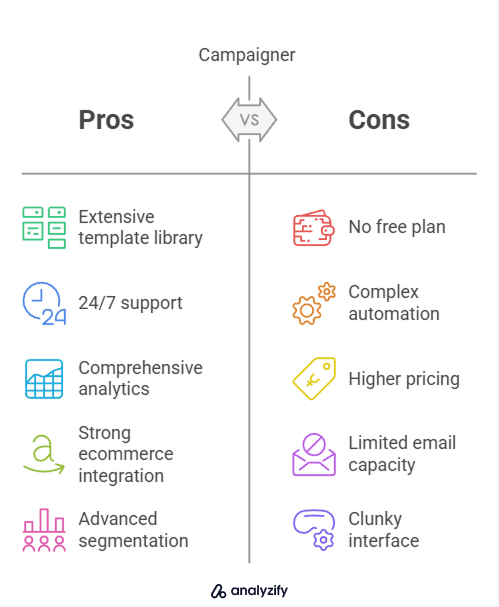
Key advantages:
- Extensive template library with over 900 options
- 24/7 phone, email, and live chat support
- Comprehensive reporting and analytics
- Strong ecommerce integration capabilities
- Advanced segmentation options
However, there are notable limitations that might affect some users. The platform’s complexity and pricing structure can be challenging for smaller businesses.
Key disadvantages:
- No free plan available
- Complex workflow automation interface
- Higher pricing compared to competitors
- Limited email send capacity (6x contact list size)
- Clunky user interface
Pricing
Campaigner offers three main pricing tiers:
| Plan | Price | Features |
| Starter Plan | $59/month for up to 5,000 contacts | Basic segmentation and A/B testing, includes Campaigner branding |
| Essential Plan | $179/month for up to 25,000 contacts | Removes Campaigner branding, e-commerce integration, multi-language support |
| Advanced Plan | $649/month for up to 100,000 contacts | Full workflow automation, API access, advanced integration options |
Additional SMS features can be added to any plan for $45/month. E-commerce plans start at $79.95/month for up to 30,000 emails with unlimited contacts.
Brevo
Brevo integrates email marketing, SMS campaigns, and CRM features in a budget-friendly platform.
Formerly known as Sendinblue, it focuses on providing advanced automation capabilities and transactional messaging tools while maintaining competitive pricing based on email volume rather than contact count.
Key Features
Brevo works best for small and medium-sized businesses looking for affordable marketing automation and transactional email capabilities.
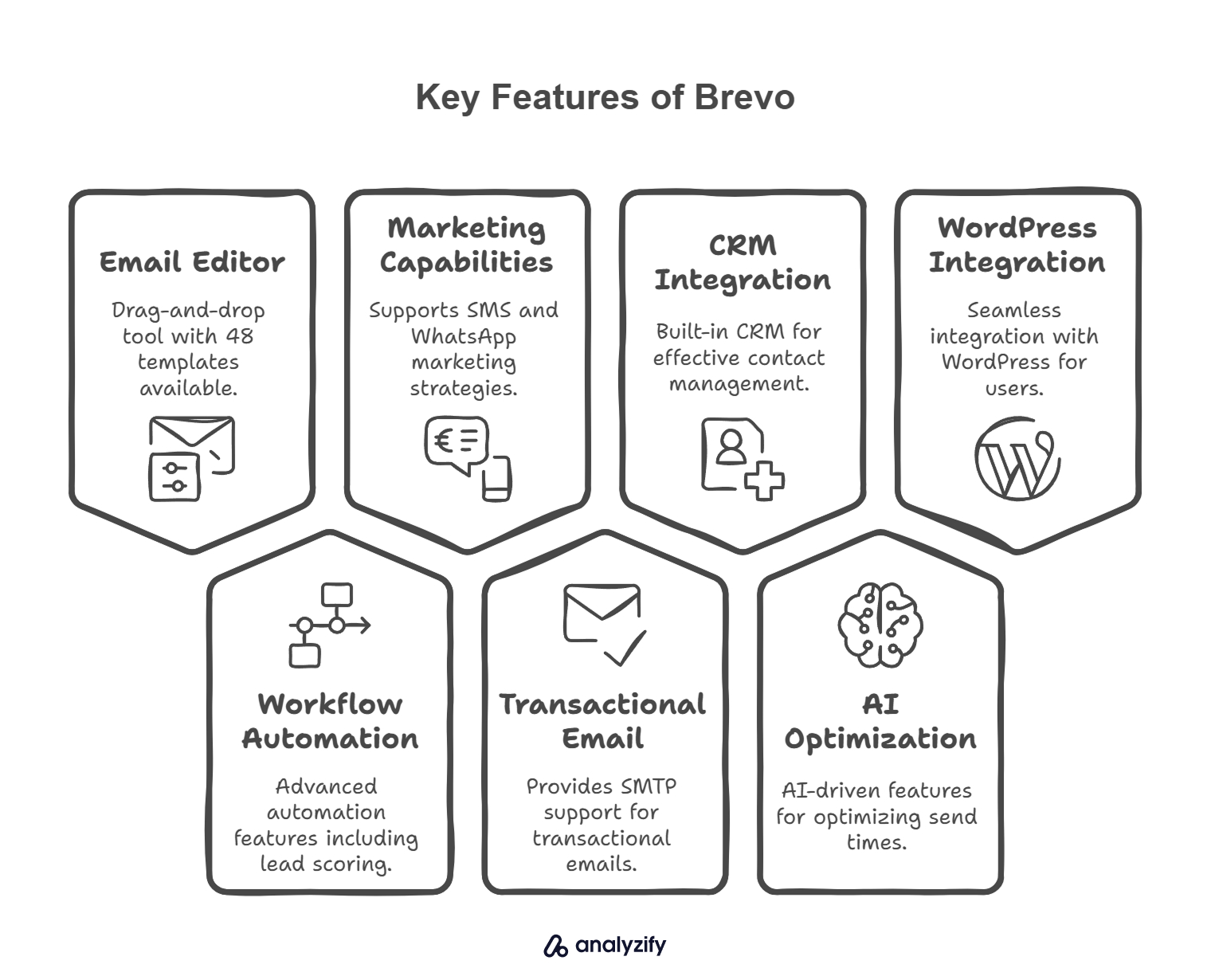
- Drag-and-drop email editor with 48 responsive templates
- Advanced workflow automation with lead scoring
- SMS and WhatsApp marketing capabilities
- Transactional email support (SMTP)
- Built-in CRM and contact management
- A/B testing and campaign analytics
- Website tracking and user behavior analysis
- AI-powered send time optimization
- WordPress integration with 80,000+ active installations
Best Suited For
It’s particularly valuable for companies that send fewer emails to the same contacts and need integrated SMS marketing features.
Advantages and Disadvantages
Brevo excels at providing advanced marketing features at competitive prices. Its unique pricing structure based on email volume rather than contact count makes it an attractive option for businesses with large contact lists but moderate sending needs.
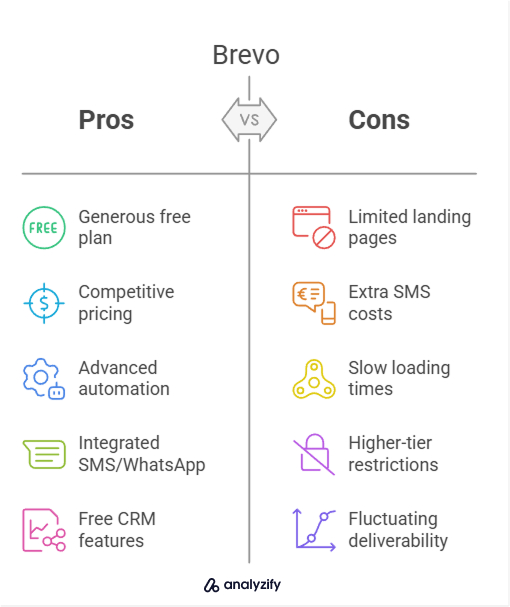
Key advantages:
- Generous free plan with up to 300 emails/day
- Competitive pricing starting at $9/month
- Advanced automation features on all plans
- Integrated SMS and WhatsApp marketing
- Strong transactional email capabilities
- Free CRM features included
However, there are notable limitations that might affect some users:
Key disadvantages:
- Limited landing page options
- Additional costs for SMS credits
- Occasionally slow loading times
- Some features restricted to higher-tier plans
- Fluctuating deliverability rates
Pricing
Brevo offers four main pricing tiers:
| Plan | Price | Features |
| Free Plan | $0 | 300 emails per day, unlimited contacts, basic email templates, SMS marketing capability |
| Starter Plan | From $9/month (Remove Brevo logo +$12/month) | 5,000 emails/month, no daily sending limit, email and SMS marketing |
| Business Plan | From $18/month | Marketing automation, advanced statistics, A/B testing capabilities, landing page builder |
| Enterprise Plan | Custom pricing | Priority support, custom features, advanced integrations, multi-user access |
AWeber
AWeber functions as an email marketing platform that focuses on newsletter creation, automation, and subscriber management.
Founded in 1998, this platform connects your email marketing, sales tracking, and customer relationship tools while offering both free and paid tiers.
Key Features
AWeber fits businesses of varying sizes looking for a straightforward email marketing solution.
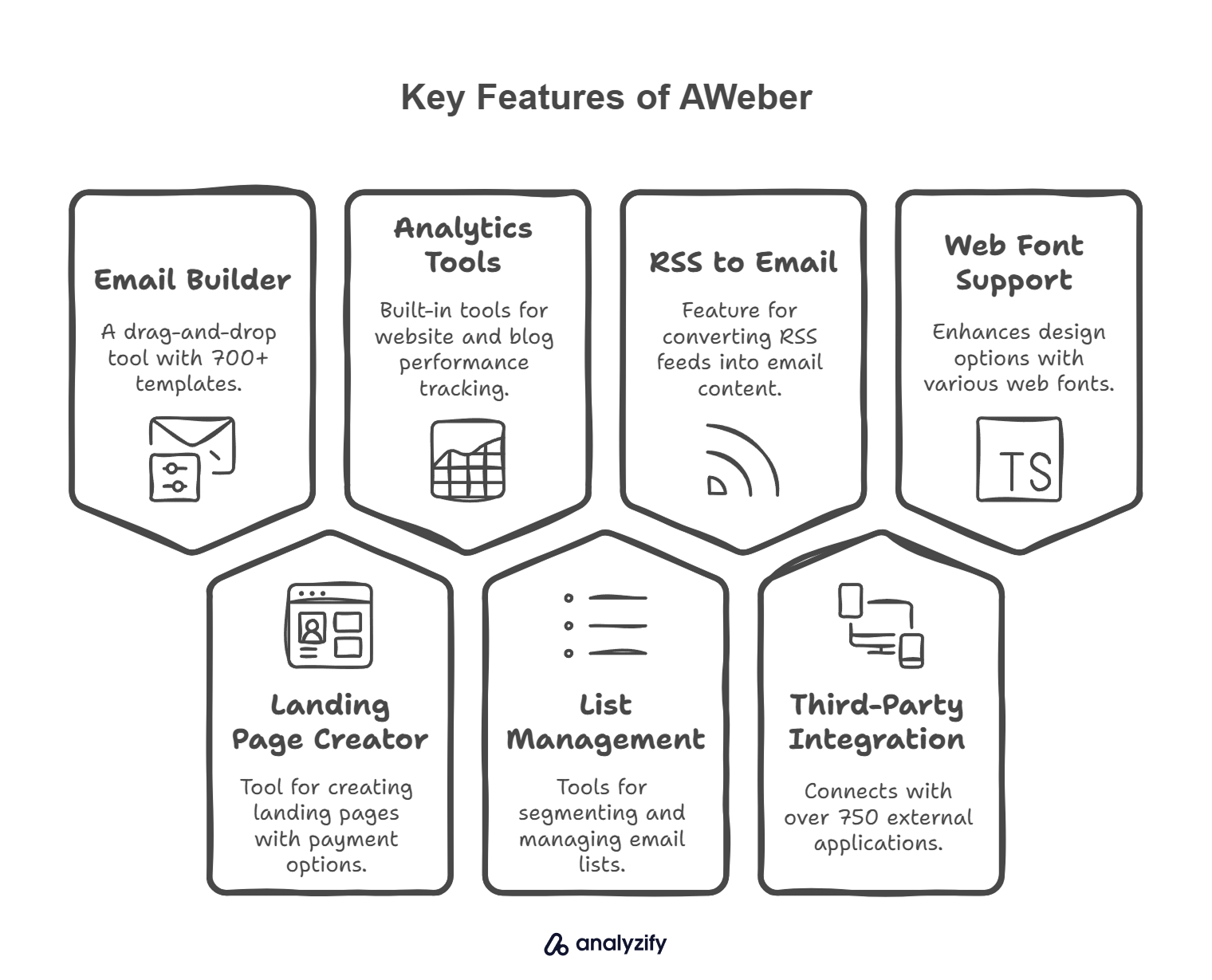
- Drag-and-drop email builder with over 700 templates
- Landing page creator with payment integration
- AI-powered content writing assistant
- Built-in website and blog analytics tools
- Marketing automation workflows
- List segmentation and management tools
- Form and popup builders
- RSS to email capabilities
- Integration with 750+ third-party apps
- Web font support for enhanced design options
Best Suited For
The platform’s tiered pricing structure makes it accessible to both startups with small subscriber lists and established companies requiring more advanced features.
Advantages and Disadvantages
AWeber shines in delivering essential email marketing capabilities while providing AI-assisted content creation. Its built-in analytics help track subscriber engagement and campaign performance.
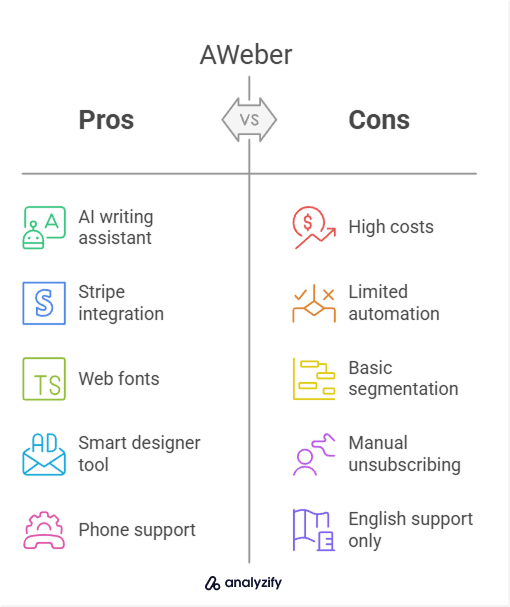
Key advantages:
- AI writing assistant helps create engaging content quickly
- Direct integration with payment processing through Stripe
- Web fonts available for enhanced email design
- Smart designer tool automatically matches brand styling
- Phone support available on all paid plans
- Built-in ecommerce features for selling products
- Integration with design tool Canva
However, users should consider several limitations before committing to the platform:
Key disadvantages:
- Monthly costs increase significantly with subscriber count
- Limited automation options in lower-tier plans
- Basic segmentation features compared to competitors
- Must manually remove unsubscribed contacts to avoid charges
- Only English-language support available
- Missing advanced A/B testing capabilities
- No automatic spam score checking
Pricing:
AWeber’s pricing model scales with your subscriber count, making it important to factor in growth when choosing this platform.
While the free tier offers basic functionality for small lists, accessing advanced features requires upgrading to paid plans which can become costly as your subscriber base grows.
Note: All prices shown are for 0-500 subscribers. Monthly and annual billing options are available, with annual billing providing cost savings.
| Plan | Price | Features |
| Unlimited Plan | $899/month, billed monthly | 15x subscriber volume monthly, unlimited everything, personalized account management, advanced features |
| Plus Plan | $30.00/month, billed monthly | 12x subscriber volume monthly, unlimited lists and pages, priority support, advanced features |
| Lite Plan | $15.00/month, billed monthly | 10x subscriber volume monthly, 1 email list, 3 landing pages, basic features with limitations |
5 Best Free Email Marketing Tools in 2025
Small businesses looking for free email marketing tools need options that balance features with zero cost.
Several email marketing platforms offer free plans that include essential features like email templates, basic automation, and subscriber management.
Let’s look at these free email marketing tools, exploring what they offer at zero cost and their limitations.
MailerLite
MailerLite provides small businesses with email marketing, automation, and website building capabilities.
The platform focuses on simplicity and ease of use, with tools for creating email campaigns, landing pages, and automated workflows without requiring technical expertise.
Key Features
MailerLite works particularly well for bloggers and content creators who want to manage their email marketing and website in one place.

- Drag-and-drop email and landing page editors
- Marketing automation workflows
- Website and blog building tools
- Subscriber management and segmentation
- A/B testing capabilities
- File management system with image editing
- E-commerce integration with Stripe
- Multi-language interface (English, Spanish, Polish)
- Mobile app for iOS
- AI writing assistant for email content
- Integration with major platforms (WordPress, Shopify, WooCommerce)
Best Suited For
Small business owners and freelancers who need email marketing tools with basic automation.
Advantages and Disadvantages
MailerLite focuses on making email marketing accessible to beginners, but this simplicity means it lacks some advanced features found in enterprise-level tools.
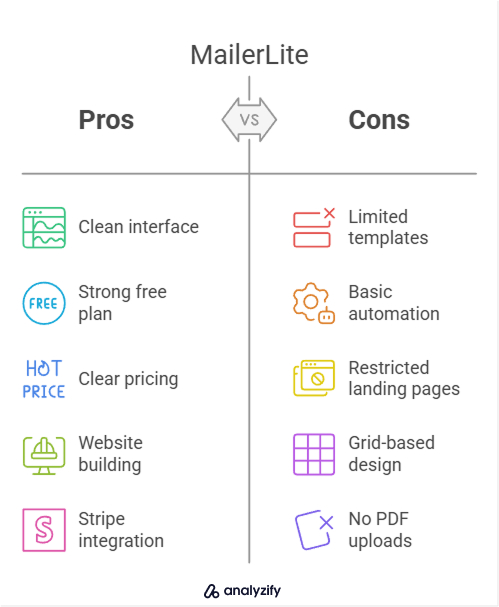
Key advantages:
- Clean interface with minimal learning curve
- Strong free plan with essential features
- Clear pricing based on subscriber count
- Built-in website building capabilities
- Direct payment processing through Stripe
- Native integration with major e-commerce platforms
The platform’s focus on simplicity creates limitations for users who need advanced marketing capabilities.
Key disadvantages:
- Limited template options in free plan
- Basic automation features compared to specialized tools
- Restricted landing page customization
- Grid-based design system limits creative freedom
- E-commerce features lack order management tools
- Image-only file storage (no PDF uploads)
Pricing:
MailerLite offers three main pricing tiers, with costs scaling based on subscriber count:
| Plan | Price | Features |
| Free Plan | $0 (Up to 1,000 subscribers) | 12,000 monthly emails, single user, basic automation features, website building tools |
| Growing Business Plan | From $10/month for 500 subscribers | Unlimited monthly emails, 3 user seats, unsubscribe page builder, digital product selling capability |
| Advanced Plan | From $20/month for 500 subscribers | All Growing Business features, unlimited users, Facebook custom audiences, multiple automation triggers, promotion pop-ups, custom HTML editor |
All paid plans increase in price based on subscriber count. For example, at 2,500 subscribers, the Growing Business plan costs $25/month and Advanced costs $39/month. The system automatically adjusts pricing when subscriber limits are exceeded.
Kit (Formerly ConvertKit)
Kit focuses on serving content creators with tools to build audiences and sell digital products. Kit combines newsletter publishing, digital storefront features, and automation tools in one integrated system designed for creators who want to monetize their content.
Key Features
Kit delivers the most value for content creators, bloggers, course creators, and digital entrepreneurs who need straightforward marketing with built-in monetization tools.
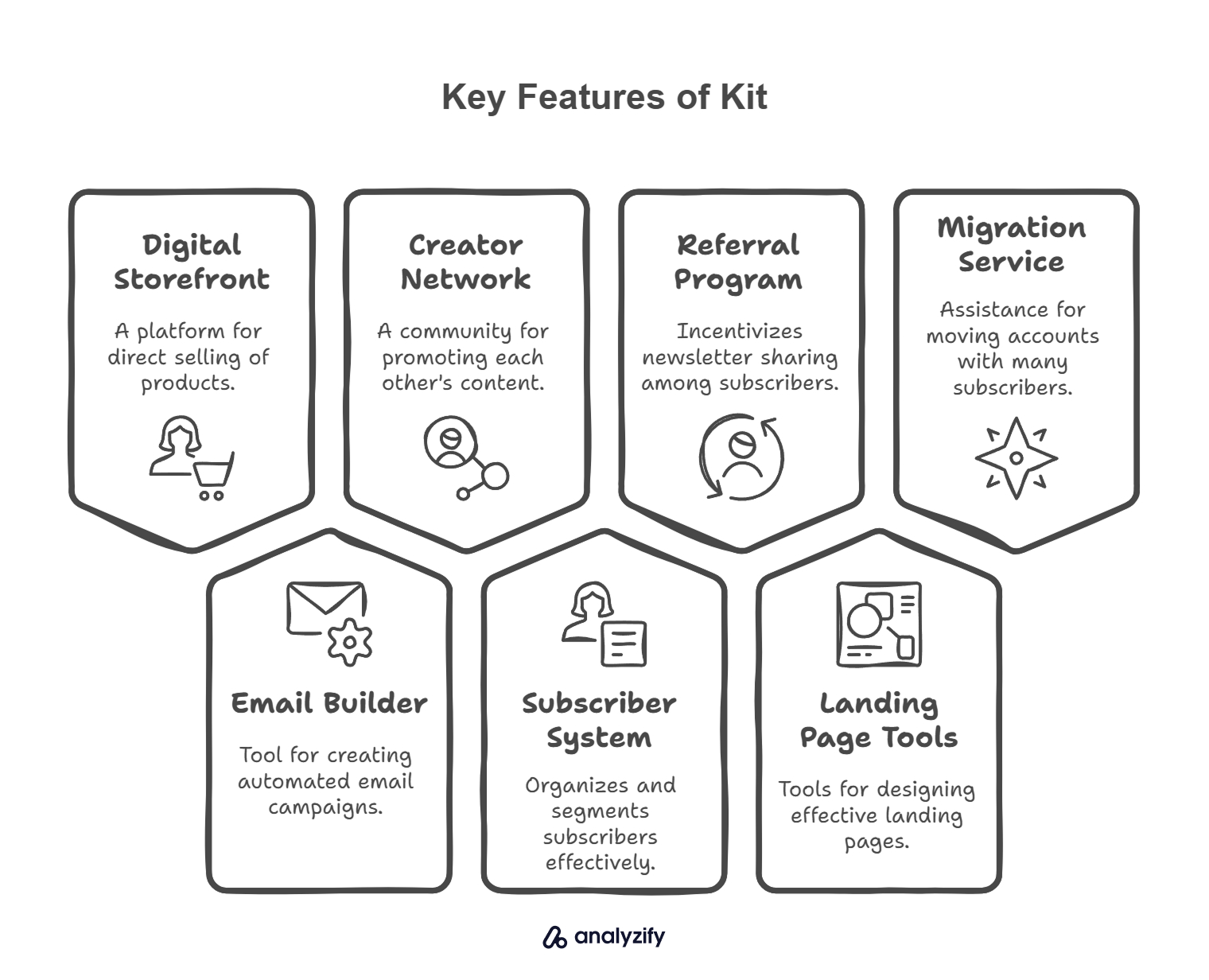
- Visual automation builder with drag-and-drop workflow creation
- Digital product storefront with direct selling capabilities
- Email sequence builder for automated campaigns
- Creator Network for cross-promotion opportunities
- Subscriber tagging and segmentation system
- Newsletter referral program
- Landing page creation tools
- Free migration service for accounts with 5,000+ subscribers
Best Suited For
Kit especially benefits creators who want to sell digital products or offer paid newsletter subscriptions without using additional software.
Advantages and Disadvantages
Kit stands out for its creator-focused features and straightforward approach to audience building. The visual automation builder makes complex sequences accessible, while the built-in commerce features eliminate the need for separate tools.

Key advantages:
- Generous free plan supporting up to 10,000 subscribers
- Built-in digital product sales with no additional tools required
- Visual automation workflows for easy campaign creation
- Free migration service for larger accounts
- Cross-promotion through Creator Network
- Direct newsletter monetization capabilities
However, some limitations may impact certain users:
Key disadvantages:
- Basic editor with limited design flexibility
- Premium plans become costly as subscriber count grows
- Limited template variety compared to competitors
- Learning curve for advanced segmentation features
- Basic analytics and reporting tools
- Requires coding knowledge for advanced personalization
Pricing
Kit structures its pricing into three tiers:
| Plan | Price | Features |
| Newsletter Plan | Free (Up to 10,000 subscribers) | One automation sequence, unlimited landing pages, basic features, community support |
| Creator Plan | Starting at $9/month for up to 300 subscribers | Unlimited automation sequences, visual automation builder, team member access, integration capabilities |
| Creator Pro Plan | Starting at $25/month for up to 300 subscribers | Everything in Creator plan, advanced reporting, newsletter referral system, subscriber scoring, priority support |
All plans include digital product selling capabilities with a 3.5% + $0.30 transaction fee. Pricing increases based on subscriber count, with custom pricing available for large lists.
Beehiiv
Beehiiv offers a specialized platform designed for content creators to build, manage and monetize newsletters.
Created by former Morning Brew team members, Beehiiv combines newsletter publishing, audience growth tools, and direct monetization features in one integrated system.
Key Features
Beehiiv serves independent writers, newsletter publishers, and content creators who want to build a sustainable business around their newsletter.
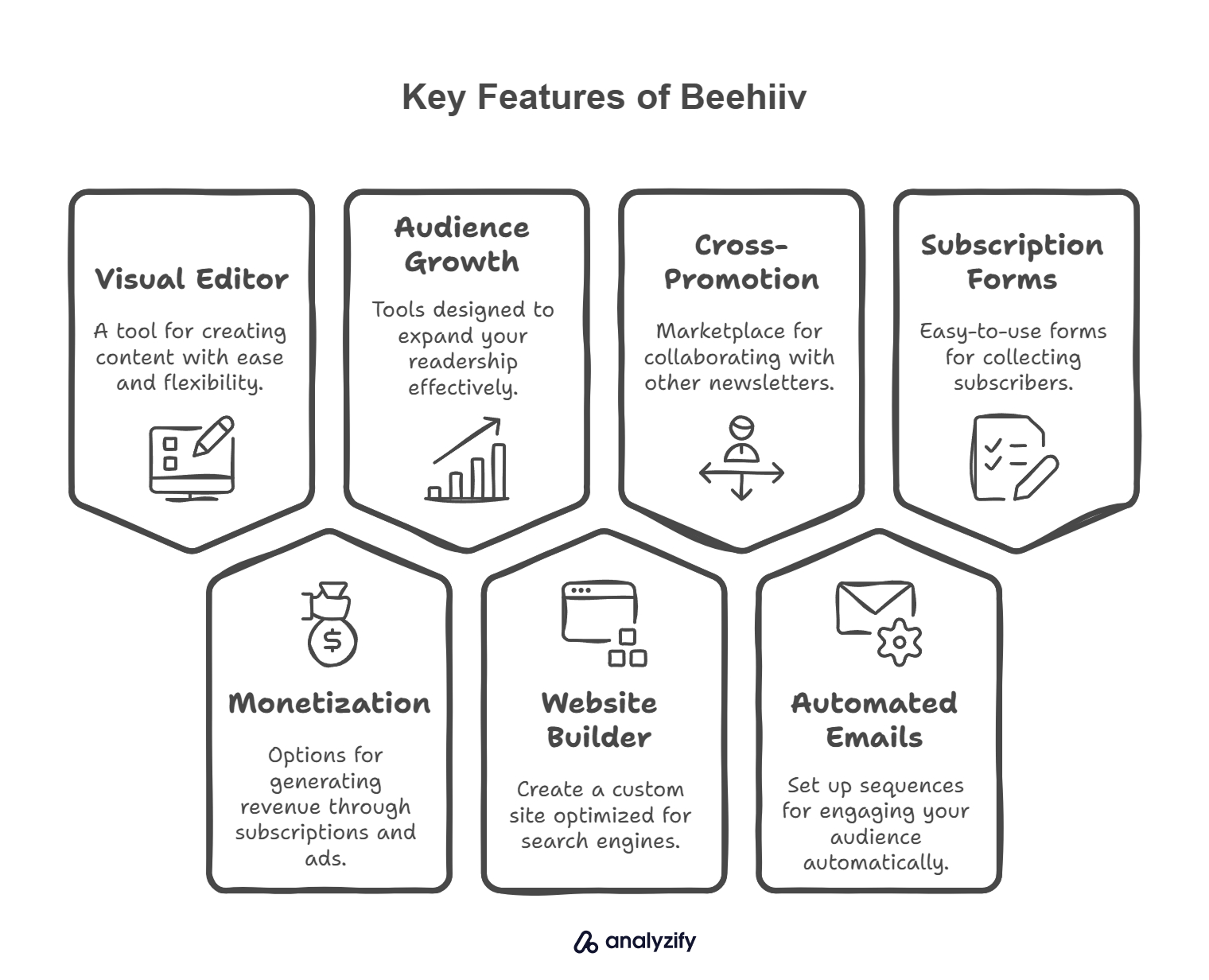
- Visual content editor with block-based formatting
- Built-in monetization through paid subscriptions and ad network
- Audience growth tools including referral system and analytics
- Custom website builder with SEO optimization
- Cross-promotion marketplace for newsletters
- AI writing assistant for content creation
- Automated email sequences
- Embeddable subscription forms
- Multi-tier subscription options
Best Suited For
The platform particularly benefits creators who plan to monetize through subscriptions or sponsorships and need integrated tools for growth and analytics.
Advantages and Disadvantages
Beehiiv excels at providing creator-focused monetization tools and growth features in a unified dashboard. The learning curve is gentle for basic features while offering depth for advanced users.
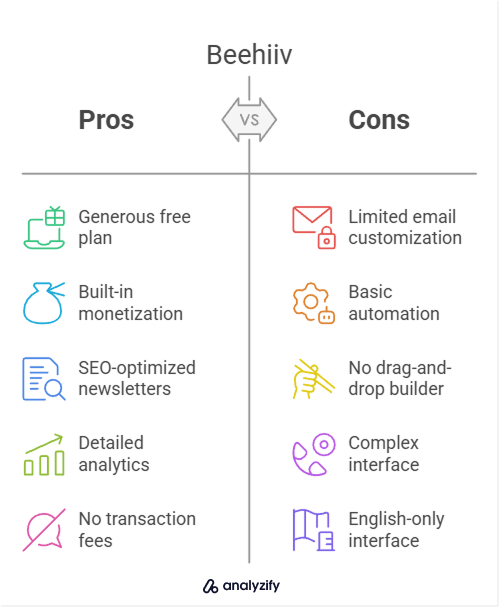
Key advantages:
- Generous free plan supporting up to 2,500 subscribers
- Built-in monetization without external integrations
- SEO-optimized web versions of newsletters
- Detailed analytics with revenue tracking
- Cross-promotion opportunities through Boost network
- No transaction fees on creator earnings
- AI assistance for content creation
However, some limitations affect certain use cases:
Key disadvantages:
- Limited email template customization options
- Basic automation capabilities compared to full-featured platforms
- No drag-and-drop email builder
- Interface can become complex with advanced features
- Limited integration options for external tools
- English-only platform interface
Pricing
Beehiiv structures its pricing into four tiers:
| Plan | Price | Features |
| Launch Plan | Free (Up to 2,500 subscribers) | Basic newsletter features, custom website, analytics dashboard, no monetization features |
| Scale Plan | $34/month (Up to 10,000 subscribers) | Ad network access, boost network for cross-promotion, email automations, advanced analytics |
| Max Plan | $86/month (Up to 100,000 subscribers) | Priority support, unlimited team seats, advanced integrations, custom branding removal |
| Enterprise Plan | Custom pricing (Custom subscriber limits) | Dedicated account manager, custom integrations, concierge onboarding, priority feature access |
All paid plans include core monetization features, audience growth tools, and website functionality. Plans scale based on subscriber count with custom pricing available for large publishers.
HubSpot
HubSpot serves as a central hub for managing customer data, running marketing campaigns, and tracking sales activities.
HubSpot connects all aspects of customer interaction, from initial website visits to completed purchases, enabling teams to oversee the entire customer journey.
Key Features
HubSpot fits well for teams that want their sales, marketing, and customer service tools in one place.
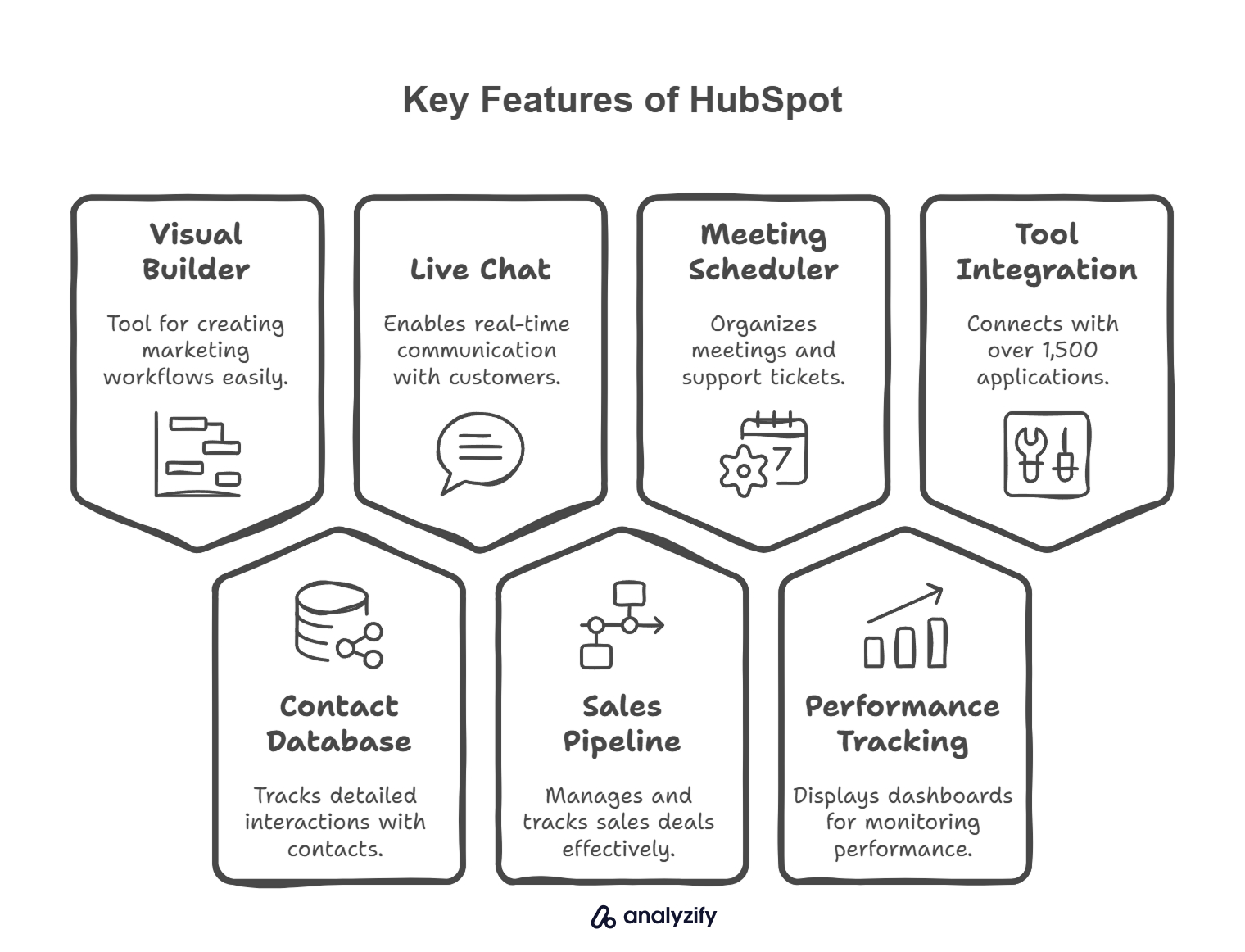
- AI tool for creating emails and social posts
- Visual builder for setting up marketing workflows
- Contact database with detailed interaction tracking
- Live chat with built-in chatbot options
- Customizable landing page creator
- Sales pipeline and deal tracking
- Meeting scheduler and support ticket system
- Performance tracking dashboards
- Website visitor monitoring
- Integration with 1,500+ tools
Best Suited For
HubSpot works for businesses of all sizes. Its free plan helps new companies start growing, while its paid tiers support established organizations with higher demands.
Advantages and Disadvantages
HubSpot stands out for its all-in-one approach to marketing and sales tools. Its core strengths include email marketing, CRM functionality, and automation capabilities, all accessible through a single dashboard.
HubSpot’s integration with sales pipelines helps businesses track deals from start to finish.
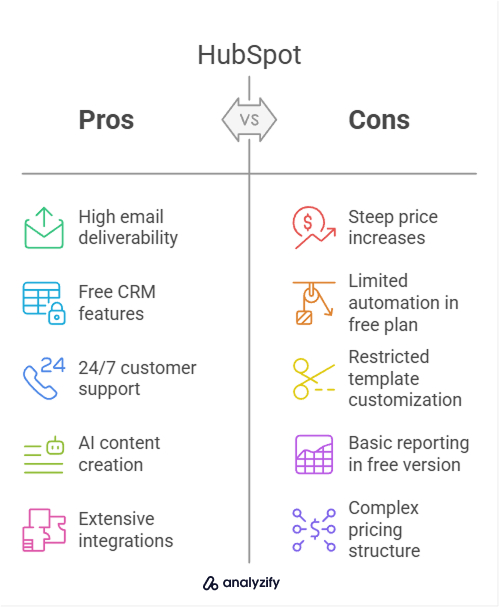
Key advantages:
- High deliverability rates for email campaigns (90%+ average)
- Full CRM features in the free version
- 24/7 customer support through chat and phone
- AI-powered content creation tools
- Connection with 1,500+ third-party platforms
- Detailed contact and company tracking
- Built-in meeting scheduling system
However, there are notable limitations that may affect some users. The platform’s pricing structure can be complex, and the jump between free and paid tiers is significant.
Key disadvantages:
- Steep price increases when upgrading plans
- Limited automation features without paid plans
- Restricted template customization options
- Basic reporting tools in free version
- Complex pricing across different hubs
- No advanced segmentation in starter plans
- Must call to cancel subscription
The interface makes daily tasks straightforward, from sending emails to managing contacts. Each feature connects naturally to the next, creating a smooth workflow for marketing and sales teams.
However, accessing advanced features requires a substantial investment in higher-tier plans.
Pricing:
HubSpot positions itself as a scalable solution across business sizes and industries. Its free tier gives teams a chance to test and implement core features, though unlocking the platform’s full potential comes at a premium price point that requires careful consideration:
| Plan | Price | Features |
| Free Plan | $0 (1 million contacts included) | 2,000 monthly emails, essential marketing tools, live chat with HubSpot logo |
| Starter Plan | $20/month starting price (1,000 marketing contacts) | No HubSpot branding, basic automation features, standard reporting tools |
| Professional Plan | $890/month starting price | Advanced automation, multi-channel marketing, custom reporting, detailed analytics |
| Enterprise Plan | Custom pricing | Full feature access, priority support, advanced reporting, enhanced security |
Mailchimp
Mailchimp combines email marketing, CRM, and website building tools in one platform. Since its acquisition by Intuit, the service has added AI-powered automation and multichannel marketing features, while increasing its prices across all plans.
Key Features
Mailchimp fits companies that prioritize ease of use over advanced customization, especially those starting with basic campaigns and planning to scale up their marketing efforts.
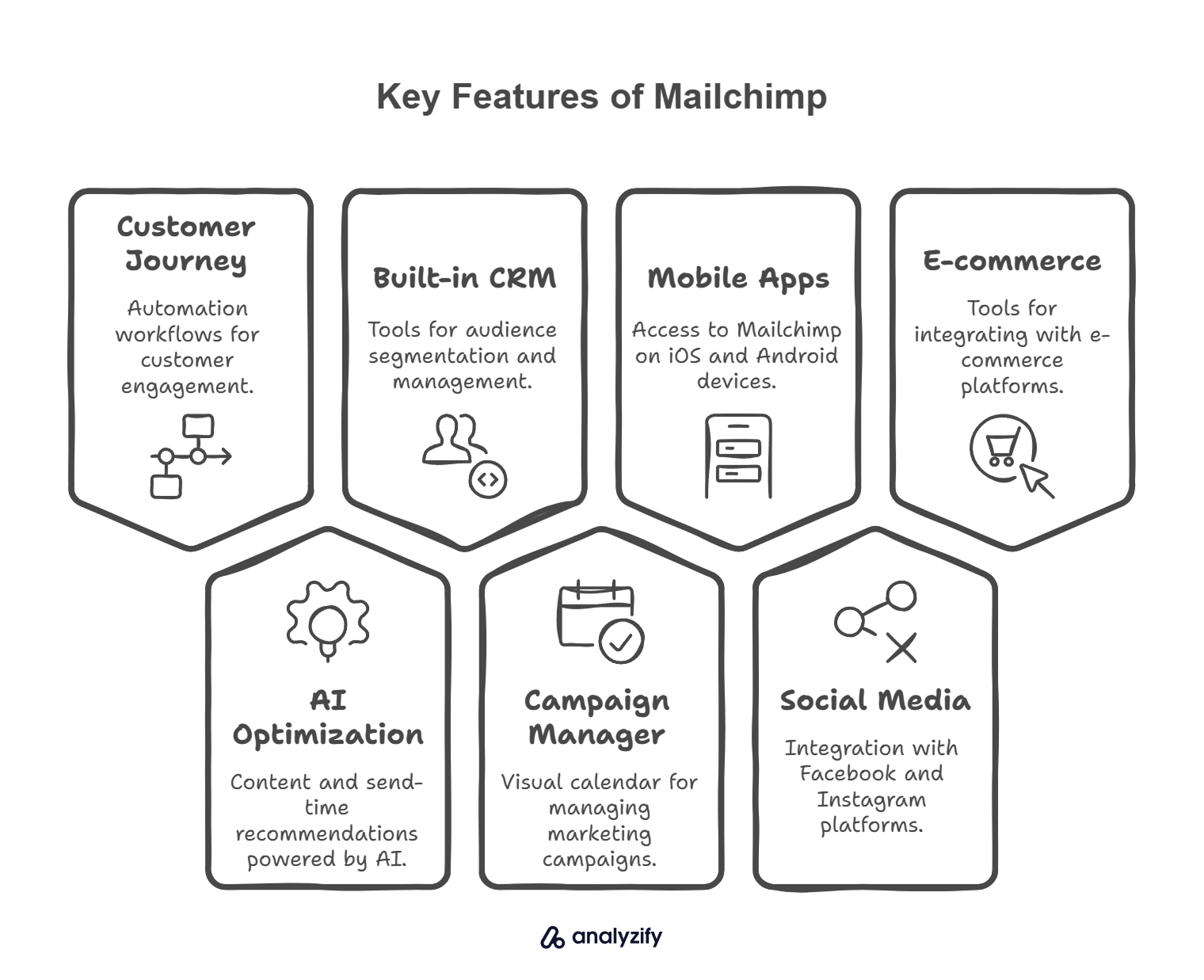
- Customer Journey builder with automation workflows
- AI-powered content optimization and send-time recommendations
- Built-in CRM and audience segmentation tools
- Over 100 pre-built email templates
- Website and landing page builder
- Campaign Manager with visual calendar
- Multivariate testing (Premium plan)
- Mobile apps for iOS and Android
- Social media integration (Facebook and Instagram)
- E-commerce platform integration
Best Suited For
Small to medium-sized businesses that want to manage email, social media, and e-commerce marketing from one platform.
Advantages and Disadvantages
Mailchimp connects email, social media, and e-commerce tools in a single platform. The interface focuses on making marketing tasks accessible to non-technical users, with built-in templates and guided workflows for common marketing tasks.
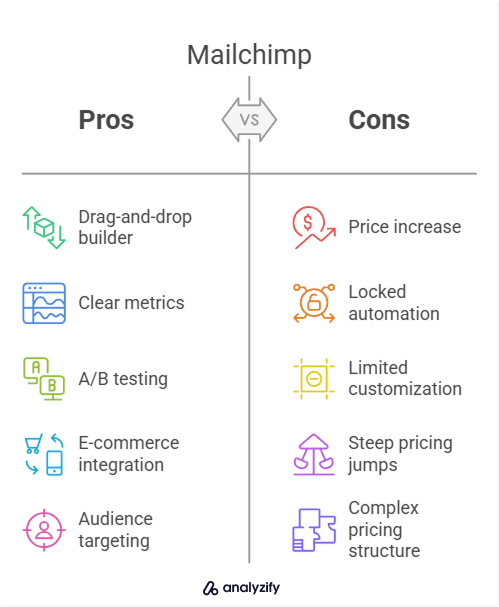
Key advantages:
- Simple drag-and-drop email builder
- Clear campaign performance metrics
- Built-in A/B testing tools
- Direct connection to major e-commerce platforms
- Detailed audience targeting options
- Practical free plan for beginners
While Mailchimp offers impressive functionality, recent pricing changes and feature restrictions have made it less competitive for growing businesses. Mailchimp ‘s move upmarket means many advanced features are now reserved for higher-tier plans.
Key disadvantages:
- Significant price increase following Intuit acquisition
- Essential automation features locked behind premium tiers
- Limited customization in email templates
- Steep pricing jumps between tiers
- Complex pricing structure based on both contacts and email volume
- Restricted API access in lower tiers
Pricing
Mailchimp offers four main pricing tiers:
| Plan | Price | Features |
| Free Plan | $0 (Up to 500 contacts) | 1,000 monthly email sends, basic templates, single user, limited automation |
| Essentials Plan | From $13/month for 500 contacts (Up to 50,000 contacts) | 5,000 monthly email sends, A/B testing, custom branding, 3 user seats |
| Standard Plan | From $20/month for 500 contacts (Up to 100,000 contacts) | 6,000 monthly email sends, custom-coded templates, advanced automation, 5 user seats, behavioral targeting |
| Premium Plan | From $350/month for 10,000 contacts (Up to 200,000+ contacts) | 150,000 monthly email sends, advanced segmentation, multivariate testing, unlimited seats, phone support |
5 Best Email Marketing Tools for Shopify in 2025
Shopify store owners need specialized email marketing tools that connect directly with their product catalog and customer data.
The best email marketing tools for Shopify help store owners recover abandoned carts, send personalized product recommendations, and track sales from email campaigns.
Here are five email marketing platforms that work exceptionally well with Shopify stores, detailing their features, benefits, limitations, and pricing structures.
Klaviyo
Klaviyo is an email and SMS marketing tool that earned Shopify’s direct investment and 11% ownership stake, making it the recommended choice for Shopify Plus merchants.
Klaviyo stands out for its predictive AI capabilities that can forecast customer behaviors like next purchase timing and churn risk, allowing stores to automate perfectly-timed marketing messages.
Key Features
The free plan offers nearly all features except AI, perfect for new stores, while paid plans suit growing businesses that can leverage predictive analytics.

- AI-powered content generation for emails and campaigns
- Built-in predictive analytics for customer behavior
- Dynamic content blocks for personalized product recommendations
- Advanced segmentation based on customer shopping patterns
- Visual flow builder for marketing automation
- Integrated SMS marketing capabilities
- Real-time tracking of customer actions
- Form builder with targeting options
- Over 70 pre-built automation templates for ecommerce
- Direct Shopify product sync and integration
Best Suited For
Klaviyo excels for ecommerce businesses needing advanced marketing automation without multiple tools.
Consider alternatives like Omnisend for stores exceeding 50,000 subscribers due to Klaviyo’s steep pricing at higher tiers.
Advantages and Disadvantages
Klaviyo’s CRM centralizes customer data and uses AI to turn this information into predictive marketing campaigns, automatically identifying optimal times for engagement based on individual shopping patterns.
Its form builder integrates with Shop Pay to capture leads and reduce cart abandonment by pre-filling customer payment details.
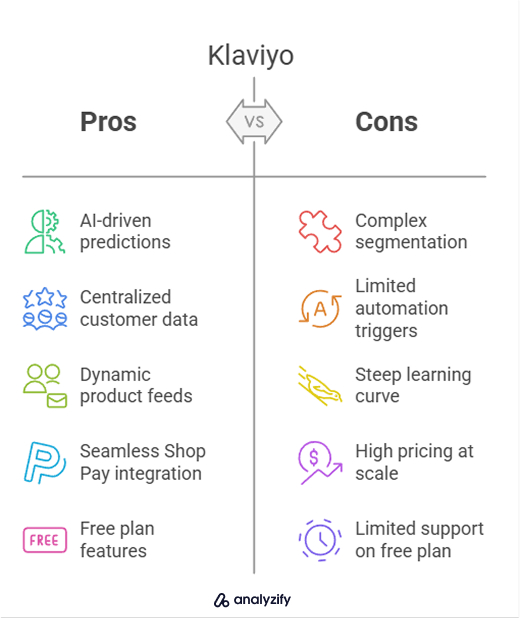
Key advantages:
- AI predicts customer behaviors and automatically optimizes sending times
- Centralized CRM that tracks all customer interactions and purchase history
- Dynamic product feeds that customize email content based on browsing history
- Advanced form targeting with Shop Pay integration for seamless checkout
- Over 70 pre-built automation templates for common ecommerce scenarios
- Access to almost all features even on the free plan
- Built-in SMS marketing that integrates seamlessly with email campaigns
The platform does face some notable challenges, particularly around its pricing structure and technical complexity. While it offers extensive capabilities, mastering them requires significant time investment and technical understanding.
Key disadvantages:
- Complex segmentation requires understanding of boolean logic and technical terms
- Limited automation triggers compared to competitors like Campaign Monitor
- Steep learning curve for utilizing advanced features effectively
- Price increases dramatically at higher subscriber counts (especially above 50,000)
- Support limited to 60 days on free plan
- No dedicated landing page builder, only form-based alternatives
- Must manually upload brand elements rather than automatic import from website
Pricing
Note: All paid plans include access to predictive analytics and AI tools. Additional SMS credits can be purchased separately. Annual billing options are not available, meaning no long-term discounts.
All pricing increases with subscriber count, with significant jumps at higher tiers.
| Plan | Price | Features |
| Free Plan | $0/month | Up to 250 contacts, 500 monthly email sends, 150 SMS/MMS credits, basic features included, 60 days of support |
| Email Plan | Starting at $20/month | Tiered pricing (500-5,000 contacts), email send limit = 10x contact number, all email features included |
| Email & SMS Plan | Contact for pricing | Higher base pricing than Email plan, includes additional SMS credits, access to all SMS features, integrated omnichannel campaigns |
ActiveCampaign
ActiveCampaign provides automation-driven email marketing with built-in CRM features for sales tracking. The platform allows users to create targeted campaigns based on subscriber behavior, with features for email, SMS, and social media marketing.
Based on tests across Gmail, Yahoo, and Outlook, it achieves email deliverability rates above 90%.
Key Features
ActiveCampaign serves businesses that need to automate their customer communications based on behavioral data.
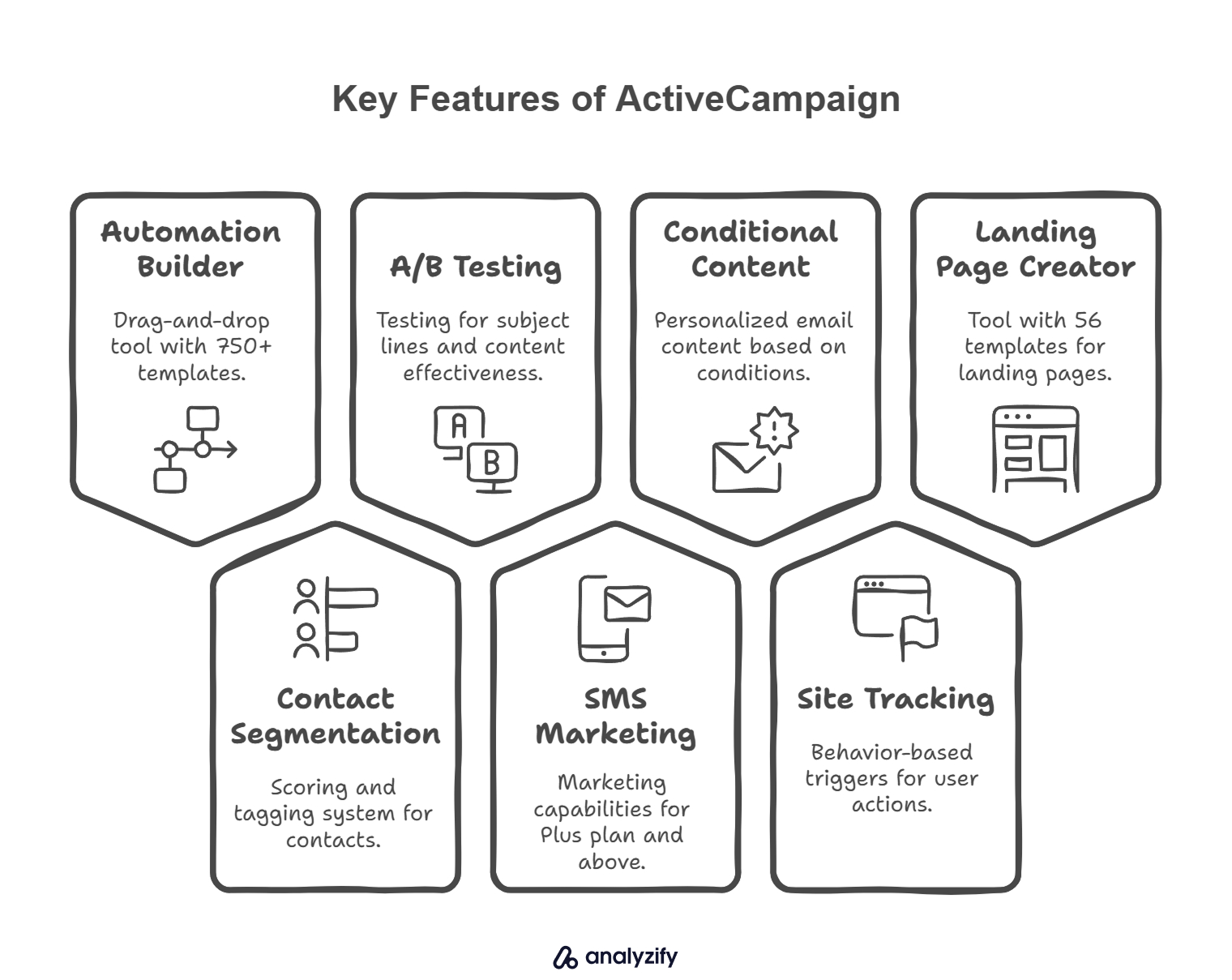
- Drag-and-drop automation builder with 750+ pre-built workflow templates
- Contact scoring and tag-based segmentation system
- Built-in deals pipeline for sales tracking
- A/B testing for subject lines and content
- SMS marketing capabilities (Plus plan and above)
- Conditional content blocks for personalized emails
- Site tracking with behavior-based triggers
- Landing page creator with 56 templates
Best Suited For
It’s particularly effective for companies running email marketing campaigns that require detailed subscriber tracking and automated follow-ups.
Advantages and Disadvantages
ActiveCampaign excels at behavior-based marketing automation with detailed contact tracking capabilities. With its integrated CRM system, users can monitor the entire customer journey from initial email contact through to sale completion.
The visual automation builder allows for complex campaign creation without requiring technical knowledge.
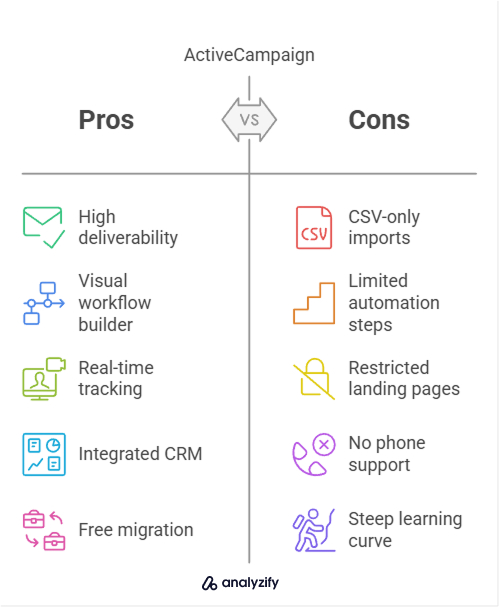
Key advantages:
- 90%+ deliverability rates across major email providers
- Visual workflow builder that supports multiple automation conditions
- Real-time site tracking and event monitoring
- Built-in CRM with sales pipeline visualization
- Free migration service from other email platforms
However, ActiveCampaign has limitations that affect certain users:
Key disadvantages:
- Accepts only CSV format for contact imports
- Starter plan limits automation to 5 steps
- Landing pages restricted to Plus plan users
- No phone support on lower-tier plans
- Interface requires significant time to master
Pricing
ActiveCampaign offers four main pricing tiers:
| Plan | Price | Features |
| Starter Plan | From $15/month | Up to 500 contacts, basic email marketing features, limited automation capabilities, up to 3 users |
| Plus Plan | From $49/month | Up to 500 contacts, advanced automation features, CRM with sales automation, landing pages and custom domain |
| Professional Plan | From $79/month | Up to 500 contacts, machine learning capabilities, attribution reporting, website personalization |
| Enterprise Plan | From $145/month | Up to 500 contacts, custom reporting, dedicated account rep, custom mailserver domain |
All plans increase in price based on contact list size. CRM features require additional fees starting at $50/month on higher tiers.
Drip
Drip provides direct customer behavior tracking and automated responses for online stores.
Drip connects with ecommerce sites like Shopify, WooCommerce, and Magento to send targeted emails based on customer actions such as cart abandonment, purchase history, and site browsing patterns.
Key Features
Drip particularly serves businesses wanting to automate their customer communications and track purchase patterns.
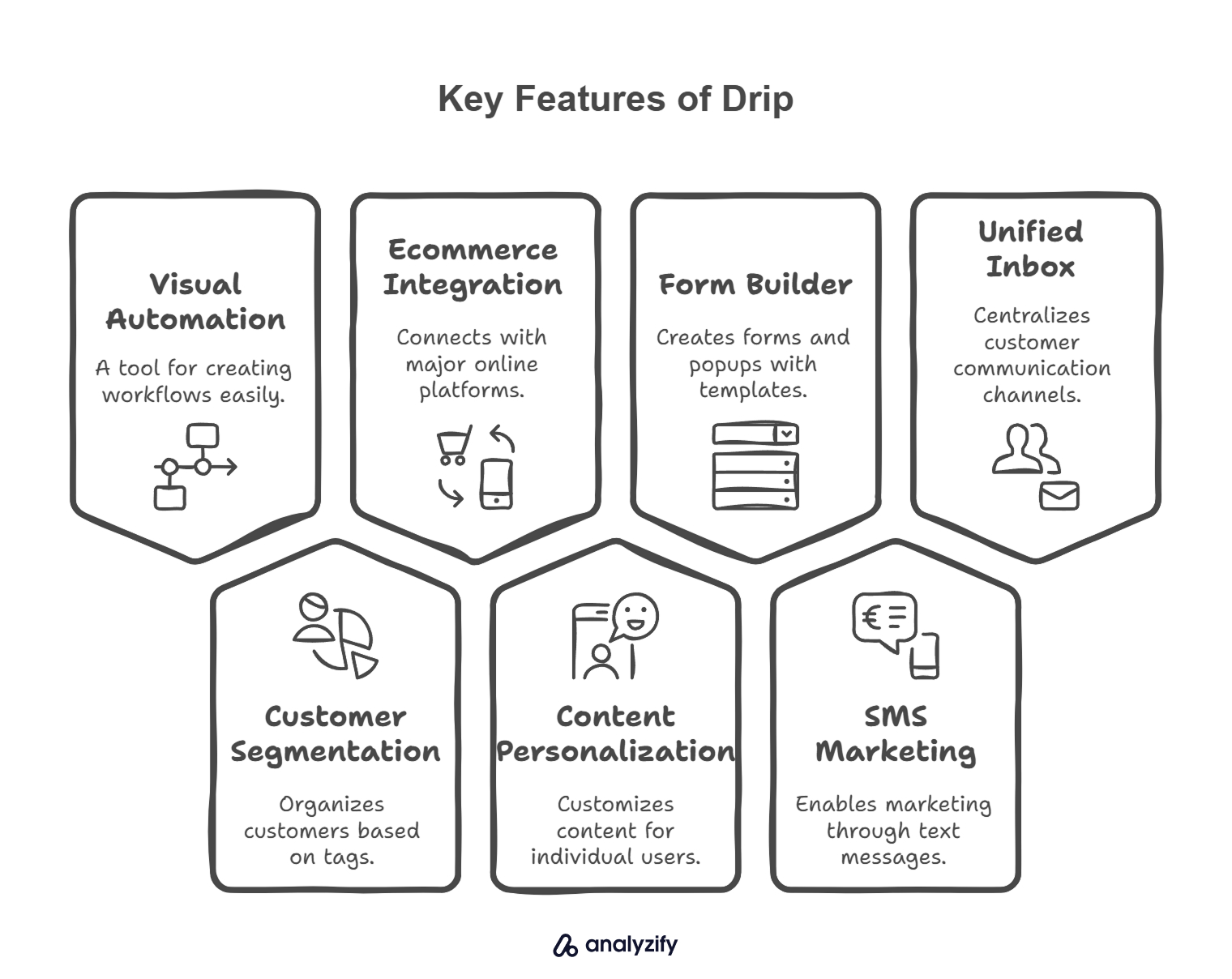
- Visual automation builder with 40+ pre-built workflow templates
- Tag-based customer segmentation and tracking
- Native integration with major ecommerce platforms
- Dynamic content personalization options
- Form and popup builder with 50+ templates
- SMS marketing capabilities on higher plans
- Advanced analytics for purchase tracking
- Unified inbox for customer communications
Best Suited For
Drip works best for ecommerce businesses and online retailers who need to create targeted marketing campaigns based on customer behavior.
Advantages and Disadvantages
Drip distinguishes itself with ecommerce-focused features and detailed analytics tracking. Users can monitor customer journeys from email engagement through purchase completion, with automated workflows triggered by specific customer actions.

Key advantages:
- Direct integration with major ecommerce platforms
- Advanced segmentation based on customer behavior
- In-depth purchase and revenue tracking
- Visual workflow builder for automation
- Real-time website visitor tracking
However, the tool has several limitations that may impact users:
Key disadvantages:
- Limited template selection (only 7 pre-made templates)
- No landing page builder functionality
- Complex navigation for new users
- Email testing restricted to subject lines
- Higher price point compared to competitors
Pricing:
Drip uses a subscriber-based pricing model where the cost adjusts based on your contact list size. Visit Drip’s pricing page and enter your number of subscribers to see the exact cost for your needs. The platform offers a 14-day free trial with no credit card required.
GetResponse
GetResponse turns website visitors into paying customers through automated funnels and behavior-based campaigns. The Polish company serves over 350,000 customers across 183 countries with tools ranging from AI-powered email templates to online course creation and webinar hosting.
Key Features
GetResponse works best for businesses looking to build complete sales funnels and automated email sequences.
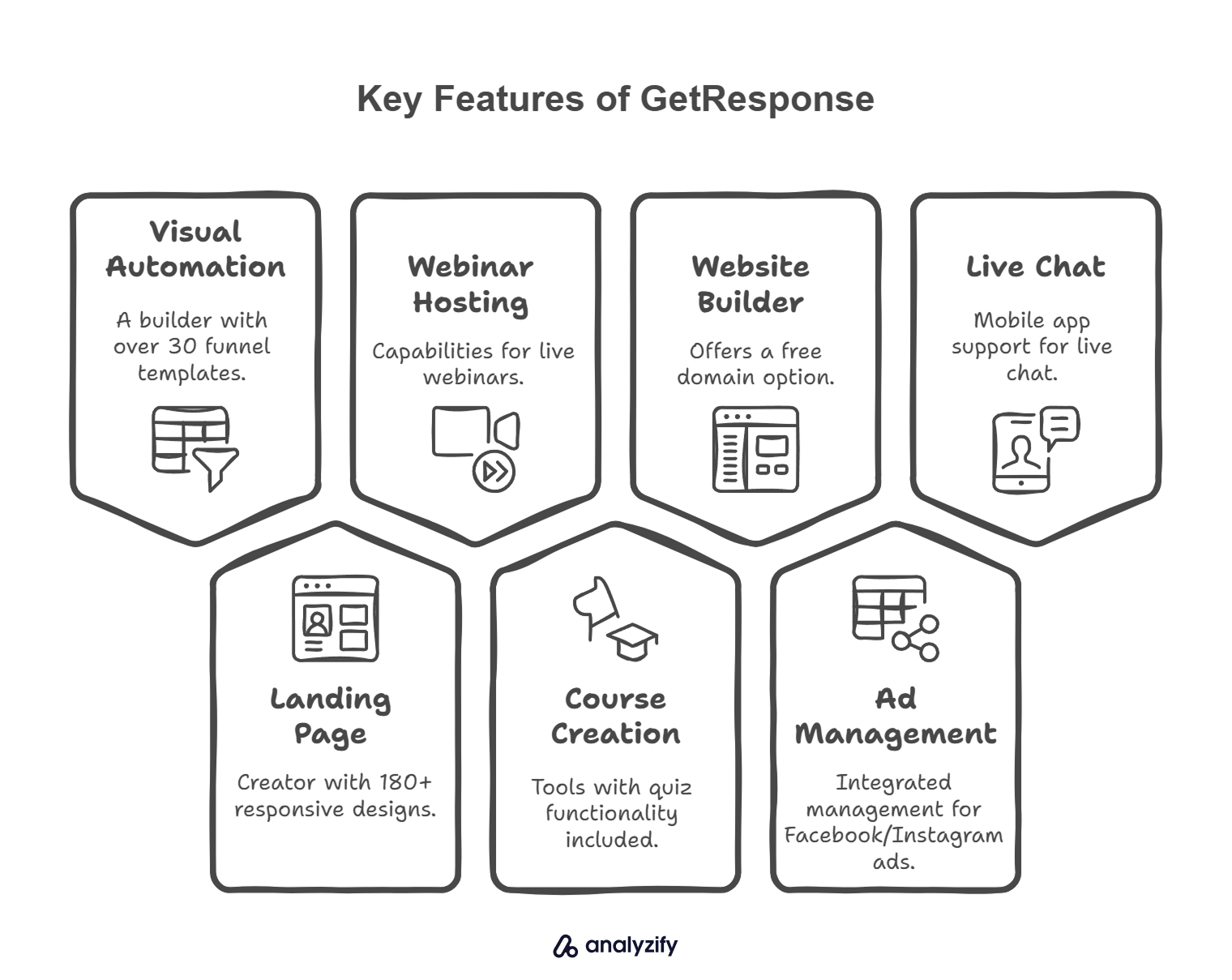
- Visual automation builder with 30+ funnel templates
- Landing page creator with 180+ responsive designs
- Built-in CRM with lead scoring and tracking
- Live webinar hosting capabilities
- Course creation tools with quiz functionality
- Website builder with free domain option
- Integrated Facebook/Instagram ad management
- Live chat with mobile app support
- AI-powered content recommendations
Best Suited For
GetResponse particularly serves online course creators, webinar hosts, and ecommerce stores needing landing pages and integrated payment processing.
Advantages and Disadvantages
GetResponse stands out with its visual workflow builder that turns complex automation sequences into simple flowcharts. Users can create entire sales funnels from landing pages to follow-up emails without needing multiple tools.
The system tracks visitor behavior across all touchpoints to trigger personalized responses.
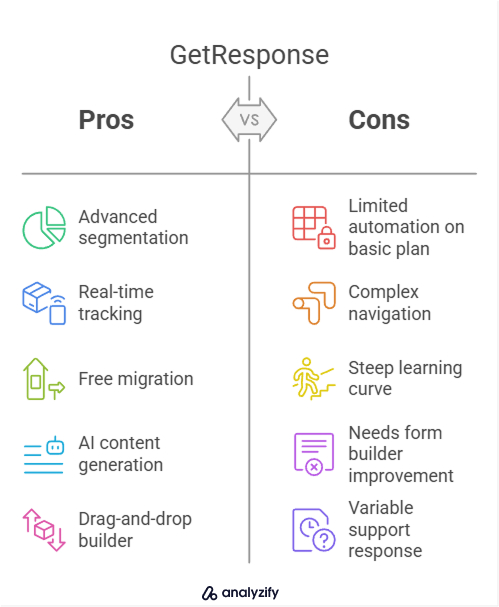
Key advantages:
- Advanced list segmentation with multiple conditions
- Real-time behavior tracking and lead scoring
- Free migration service from other platforms
- AI-powered email content generation
- Drag-and-drop funnel builder
However, the interface presents some challenges that affect daily use:
Key disadvantages:
- Automation features limited on basic plan
- Complex navigation structure
- Steep learning curve for new users
- Form builder needs improvement
- Support response times vary by plan
Pricing
| Plan | Price | Features |
| Starter | $13.24/month (annual billing)$19/month (monthly billing) | Up to 1,000 contacts, basic email features |
| Pro | $41.12/month (annual billing) | Automation tools, more templates, advanced features |
| Creator | $48.09/month (annual billing) | All Pro features plus course creation capabilities |
| Enterprise | Custom pricing | For lists over 100,000 contacts, custom features, contact sales team for pricing |
For enterprise needs or lists over 100,000 contacts, GetResponse provides custom pricing through their sales team. Users can test all features with a 30-day free trial, no credit card required.
Shopify Email
Shopify Email is an integrated email marketing solution built directly into the Shopify admin dashboard. It combines email campaign management with store analytics in a single interface.
Key Features
Shopify Email provides essential email marketing capabilities for Shopify store owners, offering direct access to product catalogs, customer lists, and basic automation features.

- Direct integration with Shopify product catalog and customer data
- Drag-and-drop email editor with pre-built templates
- Basic customer segmentation and targeting options
- Built-in analytics and campaign tracking
- Free abandoned cart email automation
- AI-powered content generation in 8 languages
- Customer group targeting capabilities
- Automatic brand element syncing
Best Suited For
Shopify Email is designed for small to medium-sized Shopify merchants who want a straightforward, cost-effective email marketing solution. It’s particularly valuable for store owners who prefer managing their email marketing directly within their Shopify dashboard and don’t require advanced automation features.
Advantages and Disadvantages
Shopify Email excels at providing basic email marketing tools with seamless Shopify store integration. Its direct connection with your store’s products, branding, and customer data makes campaign creation quick and efficient.

Key advantages:
- 10,000 free emails included monthly with any Shopify plan
- Zero-step setup process with instant store integration
- Automatic syncing of store branding and products
- Direct access to customer data and purchase history
- Multi-language AI content generation support
- Free abandoned checkout automations
However, there are notable limitations that might affect some users. The platform’s focus on simplicity means it lacks some of the advanced features found in dedicated email marketing platforms.
Key disadvantages:
- Limited automation capabilities compared to competitors
- Basic segmentation options requiring navigation to separate sections
- Fewer email templates compared to specialized platforms
- Some features require additional apps or custom coding
- Restricted template customization options
- Declining support quality based on recent user experiences
The pricing structure makes it an economical choice for Shopify merchants, particularly those just starting with email marketing. However, users needing advanced marketing features may find the platform’s limitations challenging as their business grows.
Pricing
Monthly email allocation and costs:
| Email Volume | Cost | Notes |
| 0 - 10,000 | Free | Included with any Shopify plan |
| 10,001 - 300,000 | $1.00 USD per 1,000 emails | Standard rate for medium volume |
| 300,001 - 750,000 | $0.65 USD per 1,000 emails | Discounted rate for higher volume |
| Over 750,000 | $0.55 USD per 1,000 emails | Best rate for highest volume |
Additional notes:
- Billing occurs only after costs reach $0.005 USD
- Unused emails don’t roll over to the next month
- Abandoned checkout automations are always free
- Charges appear as “Marketing emails” on monthly Shopify bill
How to Choose the Right Email Marketing Tool in 2025
Finding the right email marketing tool starts with understanding your business needs and budget. Here’s what to consider when making your choice.
Pricing Structure
Most email marketing tools base their pricing on subscriber count. Look carefully at how prices increase as your list grows - some platforms have steep jumps at certain subscriber levels.
Also check for hidden costs like extra features, SMS credits, or template access. Many platforms offer free tiers for small lists, which is perfect for testing the service before committing.
Essential Features
Start by listing the features you actually need versus those that are just nice to have. Basic features should include:
- Easy-to-use email templates
- Basic automation for welcome emails and follow-ups
- List management and segmentation
- Performance tracking and analytics
Don’t get swayed by advanced features you might never use - they often come with a higher price tag and steeper learning curve.
Technical Considerations
A good email marketing tool should be easy for your team to use daily. Test the platform’s interface during the free trial period. Check how long support takes to respond to questions, and whether they offer help in your time zone. Email deliverability rates matter too - look for platforms with rates above 90%.
Business-Specific Requirements
Your business type should guide your choice:
For Ecommerce: Choose platforms with strong product integration, abandoned cart recovery, and purchase tracking. Tools like Klaviyo and Omnisend excel here.
For Content Creators: Look for platforms with good newsletter management and subscription features. Beehiiv and Kit (formerly ConvertKit) are built specifically for this.
For Service Businesses: Focus on platforms with strong automation and CRM features, like ActiveCampaign or HubSpot.
Testing Before Committing
Take advantage of free trials and basic plans to test the platform thoroughly. Send test campaigns, try the automation features, and make sure the analytics give you the insights you need. It’s better to spend time testing now than to switch platforms later.
Email Marketing Tools: Frequently Asked Questions
Here are answers to the most common questions about email marketing tools in 2025.
Is email marketing still worth it in 2025?
Yes, email marketing remains one of the most effective marketing channels, with 4.48 billion email users worldwide. It offers direct communication with customers and typically provides a higher ROI compared to other marketing channels.
What’s the best email platform for a small business?
For small businesses, Mailchimp and Brevo offer good starting points with free plans and essential features. However, the “best” platform depends on your specific needs - consider factors like list size, automation needs, and integration requirements.
Is there a free alternative to Mailchimp?
Yes, several platforms offer free plans. Brevo provides 300 emails per day free, MailerLite offers basic features for up to 1,000 subscribers, and HubSpot includes email marketing in their free CRM package.
What’s the cheapest email marketing platform?
Brevo (formerly Sendinblue) is often the most cost-effective option, starting at $9/month with no contact limit. Their pricing is based on email volume rather than subscriber count, making it economical for businesses with large lists who send fewer emails.
How do you master email marketing?
Start with the basics: build a quality email list, segment your audience, test different content types, and analyze your results. Focus on delivering value to subscribers, maintain consistent communication, and gradually implement more advanced features as you grow.































